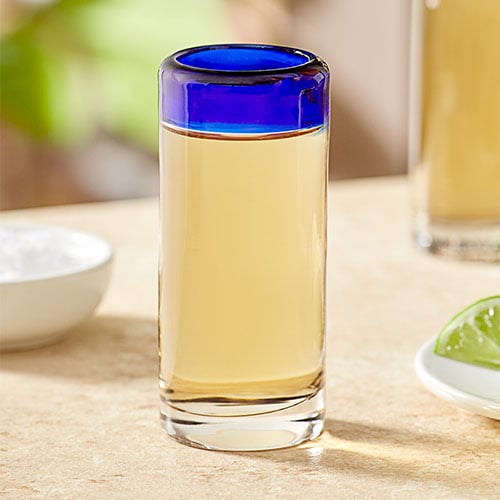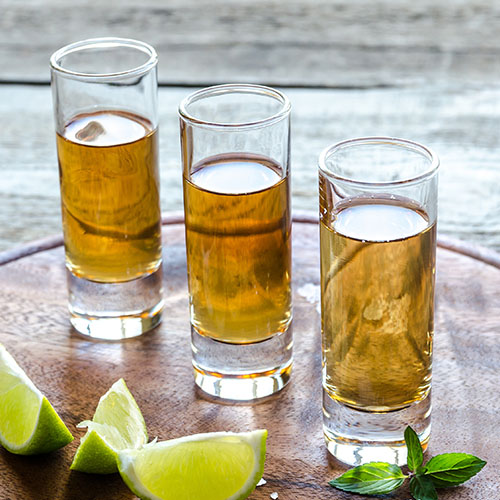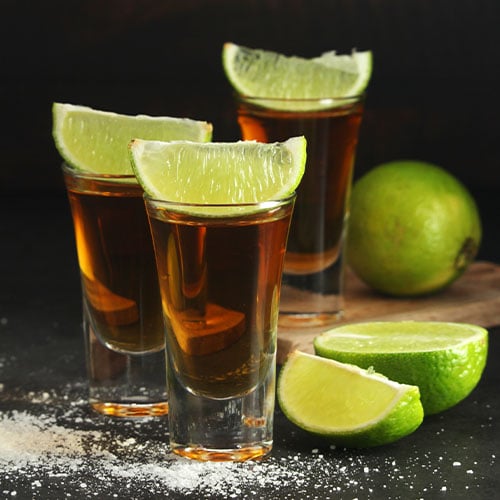Tequila, the beloved spirit from Mexico, comes in various forms that cater to different preferences and occasions. From blanco to anejo, each type offers a unique flavor profile and aging process that sets it apart. Whether you're sipping it neat, mixing up a margarita, or hosting a tequila tasting, understanding the different types of tequila can enhance your customers’ drinking experience and help you expand your bar menu.
What Is Tequila Made From?
Tequila is distilled from the blue agave plant, a succulent native to Mexico. The heart of the agave plant (the pina) is harvested and roasted to extract its juices, which are then fermented and distilled to create this foundational liquor variety. The distinct taste of tequila is influenced by the agave plant's sugars and terroir, making it a versatile ingredient in cocktails and a popular choice for sipping neat or on the rocks.
Tequila vs Mezcal
Tequila is a type of mezcal made specifically from the Weber blue agave plant in designated regions of Mexico, while mezcal can be produced from various agave species across different regions. Tequila is typically smoother and has a more defined taste profile, making it ideal for cocktails, while Mezcal offers a smokier, earthier flavor profile that appeals to those seeking more complex drinks, like spicy grapefruit mezcal margaritas. Both spirits have their unique characteristics, catering to different preferences and applications in the world of mixology and beyond.
Tequila Types
When it comes to tequila, there are several types to choose from, each offering a unique flavor profile and production process. The five types of tequila include blanco, gold, reposado, anejo, and extra anejo. Cristalino tequila is an unofficial sixth type of tequila. We explore their differences below to help you make the best decision for your business:
1. Blanco Tequila

Blanco tequila, also known as silver tequila, plata tequila, or white tequila, is a clear spirit that is unaged and bottled immediately after distillation without the influence of oak aging. Made from 100% blue agave, it is the purest form of tequila, allowing the true flavors of the agave plant to shine through. To be classified as blanco tequila, the spirit must undergo a strict production process in Mexico through the Consejo Regulador del Tequila (CRT). This ensures that each bottle of blanco tequila maintains the quality and authenticity that tequila lovers expect. Blanco tequila is often preferred for cocktails due to its crisp, clean taste and versatility in mixing. Whether you're sipping it neat or using it as the base for a refreshing margarita, blanco tequila is a staple in any bar or restaurant looking to elevate its cocktail game.
- Blanco Tequila Age: Less than two months, stored in bottles
- Blanco Tequila Flavor: Crisp with notes of citrus, pepper, and herbs, with a harsh finish
- Blanco Tequila Drinks: Margaritas and palomas
Tequila Plata vs Blanco
Tequila plata, also known as silver tequila, is the same as blanco tequila. It is an unaged and clear tequila with a crisp and clean flavor. Blanco tequila can be aged for up to two months in glass or stainless steel tanks.
2. Gold Tequila

Gold tequila, also known as joven or oro tequila, is typically a mixto tequila, meaning it is made from a combination of young blanco tequila and aged tequila to cut the sharpness. Sugars other than pure blue agave, such as cane sugar, are often added to the blend. Gold tequila is often aged in oak barrels or infused with flavorings to achieve its golden hue. This aging process imparts a smooth and slightly sweet taste to the tequila. Whether you're making margaritas, Tequila Sunrises, or simply enjoying shots with friends, gold tequila adds a touch of warmth and richness to any beverage.
- Gold Tequila Age: Varies, blend of differently aged tequilas, often stored in oak barrels
- Gold Tequila Flavor: Smooth and slightly sweet, flavor varies with the blend
- Gold Tequila Drinks: As a shot, sipped neat, in Tequila Sunrises, and margaritas
Gold vs Silver Tequila
The difference between gold and silver tequila (or blanco tequila) is the color and aging process. Gold tequila gets its color from non-agave sugars or other aged tequilas. It is often a mixto tequila, meaning it contains at least 51% agave sugars along with other sugars to give it a smooth finish. Silver tequila is 100% agave and has a pure agave flavor without any added colors or ingredients.
3. Reposado Tequila

Reposado tequila, also known as aged or rested tequila, is a popular choice among tequila enthusiasts for its unique flavor profile and smooth finish. This type of tequila is aged in oak barrels for a minimum of two months and up to one year, giving it a distinct golden hue and a complex taste. During the aging process, reposado tequila absorbs flavors from the oak barrels, resulting in notes of vanilla, caramel, and oak. This creates a well-balanced spirit that is perfect for sipping neat or as the base for cocktails like margaritas and palomas.
- Reposado Tequila Age: 2-12 months, stored in oak barrels
- Reposado Tequila Flavor: Oaky flavor with notes of vanilla, caramel, and a smooth finish
- Reposado Tequila Drinks: As a shot, neat or on the rocks, in palomas, and Tequila Manhattans
Reposado vs Blanco Tequila
The distinct difference between reposado tequila and blanco tequila is how long they are aged. Reposado tequila is aged in oak barrels for a minimum of two months but less than a year, giving it a smooth and slightly woody flavor profile. Blanco tequila is unaged and offers a fresh and crisp taste without the influence of oak aging.
Gold Tequila vs Reposado
Gold tequila is a mixto tequila with added colors, flavors, and tequila blends of different ages. Reposado tequila undergoes a brief aging process in oak barrels, resulting in a more nuanced flavor profile with hints of oak and caramel. It is not blended with other tequila types.
4. Anejo Tequila

Anejo tequila, or extra aged tequila, is known for its sophisticated flavor profile, making it a favorite choice for sipping neat or crafting premium cocktails. To be classified as Anejo tequila, the spirit must be aged in oak barrels (usually ex-whiskey barrels) for a minimum of one year but less than three years. It is stored in 600-liter batches per barrel which gives the tequila room to interact with the oak and develop a deep golden color and complex flavor profile, often with hints of dried fruit, spice, and honey. Whether enjoyed on its own or mixed into a cocktail, Anejo tequila offers a luxurious drinking experience that is sure to impress even the most discerning palates.
- Anejo Tequila Age: 1-3 years, stored in 600-liter batches in oak barrels
- Anejo Tequila Flavor: Notes of oak, vanilla, honey, dried fruits, and spices
- Anejo Tequila Drinks: Neat or on the rocks, in an Anejo Old Fashioned, and Anejo Highballs, or as a replacement for whiskey in cocktails
Anejo vs Blanco Tequila
Blanco tequila is unaged and offers a pure agave flavor with a clean finish. Anejo tequila, on the other hand, is aged for a minimum of one year but less than three years in oak barrels, resulting in a smooth and complex flavor profile with notes of vanilla and spice. While blanco tequila is clear, while anejo tequila has gold to amber hues.
Reposado vs Anejo
Reposado tequila is aged for a minimum of two months but less than a year, while anejo tequila is aged for one to three years. Anejo tequila tends to have a richer and more complex flavor profile compared to reposado, thanks to the longer aging process. Reposado tequila is usually light gold, whereas anejo tequila is typically light amber.
5. Extra Anejo Tequila

Extra anejo tequila is a premium variety of tequila, highly sought after for its rich flavor profile, strong aroma, and smooth finish. The tequila must be aged for a minimum of three years in oak barrels, giving it a dark amber color and a complex flavor profile similar to types of whiskey and cognac. This process helps to mellow out the harshness of the alcohol, resulting in a tequila that is incredibly smooth on the palate with a velvety texture. Extra anejo tequila develops rich notes of oak, chocolate, and caramel, creating a luxurious drinking experience perfect for tasting rooms. It is best enjoyed neat or on the rocks to fully appreciate its nuanced flavors.
- Extra Anejo Tequila Age: Minimum of 3 years, aged in oak barrels before being bottled
- Extra Anejo Tequila Flavor: Smooth, velvety texture, with notes of oak, chocolate, and caramel
- Extra Anejo Tequila Drinks: Neat, on the rocks, in extra anejo spicy margaritas, and Extra Anejo Manhattans
Anejo Tequila vs Extra Anejo Tequila
The difference between anejo and extra anejo tequila is their aging time. Anejo tequila is aged for a minimum of one year to three years, while extra anejo tequila is aged for a minimum of three years and beyond. While anejo is a light amber, extra anejo can be a dark amber, close to the color of cognac. Extra anejo tequila offers a rich and luxurious flavor profile with deep oak notes and a smooth finish, making it an upscale choice for tequila connoisseurs.
6. Cristalino Tequila

Cristalino tequila is not yet standardized by the Consejo Regulador del Tequila (CRT), meaning it is not considered an official type of tequila. This unique variation of tequila is worth mentioning, as it offers a fresh take on the traditional spirit, combining the smoothness of aged tequila with the clarity of a blanco. Cristalino Tequila undergoes a charcoal-filtration process that removes the color, tannins, and any impurities, resulting in a clear appearance. Despite its crystal-clear hue, this tequila still boasts the complex flavors and aromas that come from aging in oak barrels. Its refined taste and versatile nature make it a popular choice for mixing in cocktails, sipping neat, or in VIP clubs that offer bottle service.
- Cristalino Tequila Age: Varies based on the type of tequila that is charcoal-filtered
- Cristalino Tequila Flavor: Mild oakiness with crisp, bright notes of blanco tequila
- Cristalino Tequila Drinks: Sipped neat, on the rocks, in high-end margaritas and palomas
From the vibrant and versatile blanco to the rich and complex extra anejo, each type of tequila offers unique flavors and characteristics that can elevate any cocktail or bar menu. Whether you're an emerging bartender looking to craft the perfect margarita or a chef experimenting with new flavors, knowing the distinctions between tequila varieties will help you create unforgettable experiences for your customers.



